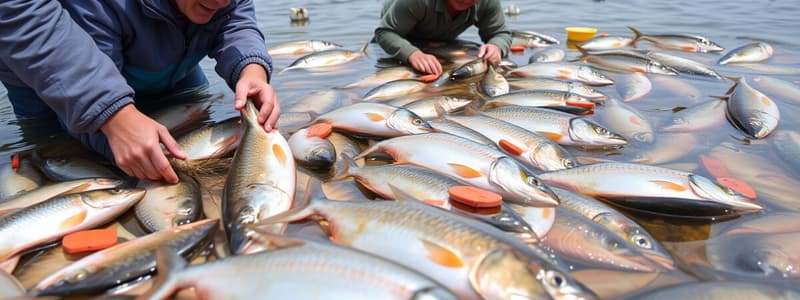Podcast
Questions and Answers
What does KPWKP stand for?
What does KPWKP stand for?
- Kawasan Perlindungan Wilayah Konservasi Pembangunan
- Kawasan Perlindungan Wilayah Konservasi Pesisir
- Komunitas Perlindungan Wilayah Konservasi Perikanan
- Kawasan Perlindungan Wilayah Konservasi Perikanan (correct)
Which is NOT a key objective of KPWKP?
Which is NOT a key objective of KPWKP?
- To ensure sustainable fisheries
- To protect marine biodiversity
- To involve local communities in conservation efforts
- To promote aggressive fishing practices (correct)
What is one of the key features of KPWKP?
What is one of the key features of KPWKP?
- Subsidies for commercial fishing
- Tax incentives for fishermen
- Unlimited fishing zones
- Zoning regulations for fishing practices (correct)
What is a challenge faced by KPWKP?
What is a challenge faced by KPWKP?
Which benefit is associated with KPWKP?
Which benefit is associated with KPWKP?
Study Notes
Overview of KPWKP
- KPWKP stands for "Kawasan Perlindungan Wilayah Konservasi Perikanan" which translates to "Fishery Conservation Area."
- Aimed at sustainable management and conservation of marine resources.
Key Objectives
- To protect marine biodiversity and habitats.
- To ensure sustainable fisheries through responsible management practices.
- To involve local communities in conservation efforts.
Key Features
-
Zoning Regulations
- Specific areas designated for different types of fishing practices.
- Restrictions on certain activities to protect sensitive ecosystems.
-
Monitoring and Enforcement
- Regular patrols and surveillance to ensure compliance with regulations.
- Penalties for illegal fishing and habitat destruction.
-
Community Engagement
- Involvement of local fishermen and communities in decision-making processes.
- Education and training programs for sustainable fishing practices.
-
Research and Data Collection
- Continuous scientific research to monitor fish populations and ecosystem health.
- Use of data to inform management decisions.
Benefits
- Preservation of marine biodiversity and ecosystems.
- Enhanced fish stocks leading to improved livelihoods for local communities.
- Promotion of eco-tourism and recreational opportunities.
Challenges
- Illegal fishing and poaching activities.
- Conflicts between conservation goals and local fishing practices.
- Need for adequate funding and resources for effective management.
Conclusion
- KPWKP represents a crucial effort in balancing the needs of fisheries with conservation goals.
- Its success relies on cooperation among stakeholders, effective enforcement, and ongoing research.
Overview of KPWKP
- KPWKP (Kawasan Perlindungan Wilayah Konservasi Perikanan) translates to "Fishery Conservation Area."
- The initiative promotes sustainable management and conservation of marine resources.
Key Objectives
- Protects marine biodiversity and habitats.
- Ensures sustainable fisheries via responsible management practices.
- Actively involves local communities in conservation efforts.
Key Features
-
Zoning Regulations
- Dedicated areas for various fishing practices to maintain ecosystem balance.
- Restrictions imposed on certain activities to safeguard sensitive ecological zones.
-
Monitoring and Enforcement
- Implementation of regular patrols and surveillance to uphold compliance with regulations.
- Establishment of penalties for violations such as illegal fishing and habitat destruction.
-
Community Engagement
- Local fishermen and communities participate in decision-making, fostering ownership and accountability.
- Provision of education and training on sustainable fishing practices to enhance community awareness.
-
Research and Data Collection
- Ongoing scientific research monitoring fish populations and overall ecosystem health.
- Data-driven management decisions informed by comprehensive research findings.
Benefits
- Helps in the preservation of marine biodiversity and ecological balance.
- Boosts fish stocks, resulting in better livelihoods for surrounding communities.
- Fosters opportunities for eco-tourism, enhancing recreational activities in the region.
Challenges
- Faces issues with illegal fishing and poaching, posing threats to conservation efforts.
- Manages conflicts between conservation objectives and traditional local fishing practices.
- Requires adequate funding and resources for effective and sustainable management.
Conclusion
- KPWKP is vital for reconciling the needs of fisheries with conservation priorities.
- Success hinges on collaborative efforts among stakeholders, stringent enforcement, and commitment to ongoing research.
Studying That Suits You
Use AI to generate personalized quizzes and flashcards to suit your learning preferences.
Description
This quiz covers the KPWKP, or Fishery Conservation Area, focusing on its objectives, features, and community engagement. Learn about the importance of sustainable management and the role of local communities in conserving marine resources. Test your knowledge on zoning regulations, monitoring enforcement, and research initiatives.




